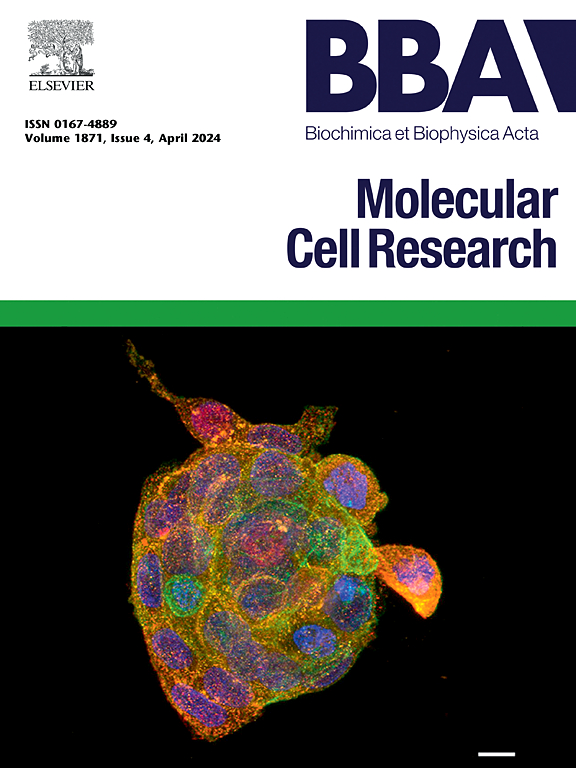Metabolomic profiling reveals grade-specific niacinamide accumulation and its therapeutic potential via SIRT1-CD38-EMT axis modulation in cervical cancer progression
IF 3.7
2区 生物学
Q1 BIOCHEMISTRY & MOLECULAR BIOLOGY
Biochimica et biophysica acta. Molecular cell research
Pub Date : 2025-06-01
DOI:10.1016/j.bbamcr.2025.119994
引用次数: 0
Abstract
Despite new therapies for cervical cancer, innovative strategies are essential to overcome drug resistance and high toxicity. The present study focuses on the metabolic profiling of cervical carcinoma using a non-targeted metabolomics approach using liquid chromatography-mass spectrometry. Our study identified over 70 metabolites in cervical tissue samples (both cancerous and adjacent normal) using HILIC and reversed-phase chromatography in the positive and negative ionization modes. Major metabolic alterations included changes in nicotinamide metabolism, ammonia recycling, amino acid metabolism and nucleotide metabolism, in a grade-dependent manner. Compared to normal tissue, HPV-positive tumors showed elevated nicotinamide metabolism, and phosphatidylethanolamine biosynthesis, whereas HPV-negative tumors showed enriched purine and pyrimidine metabolism. We validated our findings by analyzing transcriptomics datasets from the Gene Expression Omnibus database to understand the expression patterns of the underlying genes involved in the dysregulated pathways. We observed that nicotinamide metabolism exhibits significant effects in lower-grade cervical cancers and specific HPV genotypes. We treated cervical cancer cell lines with niacinamide (NAM), an amide form of niacin, to evaluate its therapeutic efficacy. NAM treatment modulated NAD+ metabolism, affecting key players such as CD38, PARP, NAMPT, and SIRT1, promoting apoptosis and inhibiting cell proliferation in cervical cancer cells. Importantly, HPV-positive SiHa cells showed elevated NAD+ metabolism relative to HPV-negative C33A cells, reflecting distinct metabolic adaptations that may influence tumor progression. The study highlights the metabolic shifts in cancer progression and provides insights into NAM's molecular mechanisms and therapeutic potential for precision medicine in cervical cancer.
代谢组学分析揭示了级别特异性烟酰胺积累及其通过SIRT1-CD38-EMT轴调节在宫颈癌进展中的治疗潜力
尽管宫颈癌有新的治疗方法,但创新的策略对于克服耐药性和高毒性至关重要。本研究的重点是利用液相色谱-质谱法的非靶向代谢组学方法对宫颈癌的代谢谱进行分析。我们的研究使用HILIC和反相色谱法在正负电离模式下鉴定了70多种宫颈组织样本(包括癌组织和邻近正常组织)的代谢物。主要代谢变化包括烟酰胺代谢、氨循环、氨基酸代谢和核苷酸代谢的变化,并呈等级依赖性。与正常组织相比,hpv阳性肿瘤显示烟酰胺代谢和磷脂酰乙醇胺生物合成升高,而hpv阴性肿瘤显示嘌呤和嘧啶代谢丰富。我们通过分析来自Gene Expression Omnibus数据库的转录组学数据集来验证我们的发现,以了解参与失调通路的潜在基因的表达模式。我们观察到烟酰胺代谢在低级别宫颈癌和特定HPV基因型中表现出显著的影响。我们用烟酰胺(烟酸的一种酰胺形式)治疗宫颈癌细胞系,以评估其治疗效果。NAM处理可调节NAD+代谢,影响CD38、PARP、NAMPT、SIRT1等关键因子,促进宫颈癌细胞凋亡,抑制细胞增殖。重要的是,与hpv阴性的C33A细胞相比,hpv阳性的SiHa细胞显示出更高的NAD+代谢,反映了可能影响肿瘤进展的独特代谢适应。该研究强调了癌症进展中的代谢变化,并为宫颈癌精准医学的分子机制和治疗潜力提供了见解。
本文章由计算机程序翻译,如有差异,请以英文原文为准。
求助全文
约1分钟内获得全文
求助全文
来源期刊
CiteScore
10.00
自引率
2.00%
发文量
151
审稿时长
44 days
期刊介绍:
BBA Molecular Cell Research focuses on understanding the mechanisms of cellular processes at the molecular level. These include aspects of cellular signaling, signal transduction, cell cycle, apoptosis, intracellular trafficking, secretory and endocytic pathways, biogenesis of cell organelles, cytoskeletal structures, cellular interactions, cell/tissue differentiation and cellular enzymology. Also included are studies at the interface between Cell Biology and Biophysics which apply for example novel imaging methods for characterizing cellular processes.

 求助内容:
求助内容: 应助结果提醒方式:
应助结果提醒方式:


